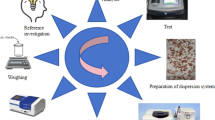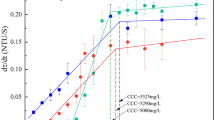Abstract
Enhanced oil recovery research focuses on the phenol–formaldehyde resin (PFR) solution (EOR). We studied PFR’s morphology and aggregation kinetics at various pH levels. A hydrated layer formed on the surface of PFR as a result of hydrogen bonding between the hydroxyl and phenolic hydroxyl groups and water molecules. We quantitatively quantified the impact of pH on the morphology and aggregation kinetics of PFR by incorporating the hydrated force into the DLVO (Derjaguin Landau Verwey Overbeek) theory. We were able to predict the situation of aggregates plugging into the reservoir by altering the size of PFR aggregates in a capillary.
Graphical Abstract















Similar content being viewed by others
References
Al-Saedi HN, Flori RE, Al-Bazzaz W et al (2020) Will coupling low salinity water and steam flooding for heavy oil affect the rock properties of sandstone reservoirs? An experimental and simulation study. J Mol Liq 306
do Vale TO, de Magalhaes RS, de Almeida PF, Torres Lima Matos JB, Chinalia FA et al (2020) The impact of alkyl polyglycoside surfactant on oil yields and its potential effect on the biogenic souring during enhanced oil recovery (EOR). Fuel 280
Rezaeiakmal F, Parsaei R (2021) Visualization study of polymer enhanced foam (PEF) flooding for recovery of waterflood residual oil: effect of cross flow. J Pet Sci Eng 203
Sagir M, Mushtaq M, Tahir MB, Tahir MS, Ullah S, Shahzad K, Rashid U et al (2018) CO2 foam for enhanced oil recovery (EOR) applications using low adsorption surfactant structure. Arab J Geosci 11(24)
Yu H, Wang Y, Ji W, Zhang J, Zhang P, Chen W, Qi Z (2011) Study of a profile control agent applied in an offshore oilfield. Pet Sci Technol 29(12):1285–1297
Zhang Y, Hu Q, Yang S, Wang T, Sun W, Tong Z (2021) Unique self-reinforcing and rapid self-healing polyampholyte hydrogels with a pH-induced shape memory effect. Macromolecules 54(11):5218–5228
Chen H, Yang M, Chen K, Zhang C et al (2020) Relative permeability of porous media with nonuniform pores. Geofluids
Clarkson CR, Yuan B, Zhang Z, Tabasinejad F, Behmanesh H, Hamdi H, Anderson D, Thompson J, Lougheed D et al (2020) Evaluation of the impact of multi-phase flow on reservoir signatures in the Wolfcamp shale. J Nat Gas Sci Eng 76
Leng J, Lin X, Wang L (2021) Effects of osmosis on Darcy flow in shales. Energy Fuels 35(6):4874–4884
Sharma A, Swami D, Joshi N, Chandel A, Simunek J et al (2021) The semi-analytical solution for non-equilibrium solute transport in dual-permeability porous media. Water Resour Res 57(5)
Hakim A, Suzuki T, Kobayashi M (2019) Strength of humic acid aggregates: effects of divalent cations and solution pH. ACS Omega 4(5):8559–8567
Xu Z, Sun Y, Niu Z, Xu Y, Wei X, Chen X, Pan D, Wu W et al (2020) Kinetic determination of sedimentation for GMZ bentonite colloids in aqueous solution: effect of pH, temperature and electrolyte concentration. Appl Clay Sci 184
Ishikawa Y, Katoh Y, Ohshima H (2005) Colloidal stability of aqueous polymeric dispersions: effect of pH and salt concentration. Colloids and Surfaces B-Biointerfaces 42(1):53–58
Kozhevnikov EV, Turbakov MS, Gladkikh EA, Riabokon EP, Poplygin VV, Guzev MA, Qi C, Kunitskikh AA (2022) Colloid migration as a reason for porous sandstone permeability degradation during coreflooding 15(8):2845
Zhao D, Yang, H, Li Z, Wei Y, Li G, Tian Y, Yang W, Tang Z, Wang L, Li J, Feng H et al (2022) Aggregation kinetics and morphological changes of PFR and establishment of triple-layer surface complexation model to explain ion difference. Colloid Polym Sci
Hakim A, Kobayashi M (2018) Aggregation and charge reversal of humic substances in the presence of hydrophobic monovalent counter-ions: effect of hydrophobicity of humic substances. Colloids Surf, A 540:1–10
Rahn-Chique K, Puertas AM, Romero-Cano MS, Rojas C, Urbina-Villalba G (2012) Nanoemulsion stability: experimental evaluation of the flocculation rate from turbidity measurements. Adv Coll Interface Sci 178:1–20
Morán J, Henry C, Poux A, Yon J (2021) Impact of the maturation process on soot particle aggregation kinetics and morphology. Carbon 182:837–846
Tang S, Preece JM, McFarlane CM, Zhang Z (2000) Fractal morphology and breakage of DLCA and RLCA aggregates. J Colloid Interface Sci 221(1):114–123
Takeya M, Shimokawara M, Elakneswaran Y, Nawa T, Takahashi S (2019) Predicting the electrokinetic properties of the crude oil/brine interface for enhanced oil recovery in low salinity water flooding. Fuel 235:822–831
van der Linden M, Conchúir BO, Spigone E, Niranjan A, Zaccone A, Cicuta P (2015) Microscopic origin of the Hofmeister effect in gelation kinetics of colloidal silica. The J Phys Chem Lett 6(15):2881–2887
Acknowledgements
We appreciate Dr. Huixia Feng’s insightful conversation. We are grateful that the PetroChina Lanzhou Lubricating Oil R&D Institute provided the measuring tools.
Funding
The Natural Science Foundation of China (Grant numbers: 2020IM030400), the Special Project on Innovative Methods Fund Program of the Ministry of Science and Technology of the People’s Republic of China, and the Natural Science Foundation of China all provided financial support for this study (Grant numbers: 21664009,51063003).
Author information
Authors and Affiliations
Corresponding author
Ethics declarations
Conflict of interest
The authors declare no competing interests.
Additional information
Publisher's Note
Springer Nature remains neutral with regard to jurisdictional claims in published maps and institutional affiliations.
Supplementary Information
Below is the link to the electronic supplementary material.
Rights and permissions
Springer Nature or its licensor (e.g. a society or other partner) holds exclusive rights to this article under a publishing agreement with the author(s) or other rightsholder(s); author self-archiving of the accepted manuscript version of this article is solely governed by the terms of such publishing agreement and applicable law.
About this article
Cite this article
Zhao, D., Yang, H., Wei, Y. et al. pH-responsive phenol–formaldehyde resin: aggregation mechanism and plugging science. Colloid Polym Sci 301, 1295–1304 (2023). https://doi.org/10.1007/s00396-023-05144-8
Received:
Revised:
Accepted:
Published:
Issue Date:
DOI: https://doi.org/10.1007/s00396-023-05144-8




